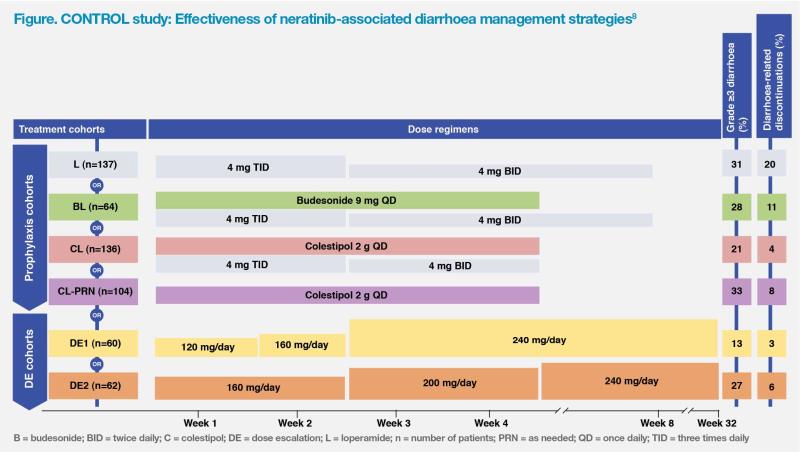1-year extended adjuvant therapy in a patient with HER2- and HR-positive breast cancer without pCR after surgery





Presentation and investigations
A 45-year-old premenopausal female who was otherwise healthy presented in September 2020 with a lump, which was the size of an egg yolk, in her right breast. Diagnostic workup revealed multiple irregularly edged masses in the right breast, with the largest located in the upper outer quadrant measuring approximately 37 x 21 mm, and multiple enhanced lymph nodes (LNs) of approximately 13 x 10 mm in the right armpit. Biopsy of the breast mass and LNs showed invasive HER2-positive and hormone receptor (HR)–positive (both oestrogen receptor– and progesterone receptor–positive) ductal carcinoma, with a Ki-67 level of 20 percent. The patient was diagnosed with HER2-positive breast cancer (BC; cT2NxM0).
Treatment and response
After a discussion with the patient and her family, the patient was enrolled in a clinical trial. She received neoadjuvant therapy with pyrotinib, a cyclin-dependent kinase 4/6 inhibitor, goserelin acetate and letrozole for 5 months. In March 2021, a follow-up MRI scan showed shrinkage of the breast mass (16 x 8 mm) and smaller LNs in the right armpit. Subsequently, the patient underwent breast-conserving mastectomy, but pathological complete response (pCR) was not achieved after surgery (non-pCR; Miller–Payne grade 3). Postoperative pathological diagnosis was right invasive ductal carcinoma of the breast, staged IIIC (pT2N3M0).
Adjuvant therapy with six cycles of paclitaxel and dual-targeted therapy (trastuzumab plus pertuzumab [HP]) was commenced in July 2021. Between August and October 2021, the patient received four cycles of additional chemotherapy with epirubicin and cyclophosphamide, as well as endocrine therapy to protect ovarian function and radiotherapy to the right breast and supraclavicular area to enhance local control. From October 2021 to May 2022, she received targeted therapy with HP.
In June 2022, the patient started a 1-year course of extended adjuvant therapy with neratinib. In the first week of neratinib treatment, she experienced grade 2 diarrhoea (6 times daily) and was treated with a traditional Chinese medicine (TCM) herbal formula, Shenling Baizhu San (SLBZS). After 2 weeks of SLBZS, the diarrhoea significantly improved, and she completed neratinib treatment in May 2023.
As of October 2024, the patient was well with no signs of recurrence, and undergoing regular follow-up.
Discussion
HER2-positive BC accounts for 15–25 percent of all invasive BC cases and is associated with aggressive histopathologic features and poor clinical outcomes.1 Although trastuzumab has considerably improved the prognostic landscape of HER2-positive BC in all settings, the associated pCR rates of neoadjuvant trastuzumab-containing regimens are 30–60 percent, with 3-year relapse-free survival rates of 71–78 percent. This indicates that a substantial number of HER2-positive BC patients still have residual disease after surgery.2 Evidence suggests that patients with residual disease or non-pCR status, as well as those with HER2-positive/HR-positive disease, node positivity, higher body mass index, larger primary tumour size and higher Ki67 index are at increased risk of recurrence.3
HER2-positive/HR-positive BC represents a distinct subtype of BC, which is less likely to respond to standard combination of anti-HER2 and chemotherapy, and therefore requires the addition of endocrine therapy.4 In the neoadjuvant setting, significantly lower pCR rates are seen in HR-positive than HR-negative tumours, regardless of HER2-targeted treatment type.2
Since our patient with HER2-positive/HR-positive BC was considered at high risk of recurrence because of her non-pCR status and node positivity after neoadjuvant therapy, she received dual-targeted adjuvant HP, which was shown to reduce the risk of recurrence in the APHINITY study.5 She also received guideline-recommended extended adjuvant therapy with neratinib to further improve outcomes.5
Neratinib is an irreversible, small-molecule pan-HER tyrosine kinase inhibitor indicated for extended adjuvant treatment of adult patients with early-stage HR-positive HER2-overexpressed/amplified BC who completed adjuvant trastuzumab-based therapy <1 year ago.6 In the phase III ExteNET study, 1-year extended adjuvant therapy with neratinib significantly improved survival outcomes in patients with HER2-positive/HR-positive BC, with absolute benefit in 5-year invasive disease-free survival (iDFS) and 8-year overall survival (OS) of 5.1 and 2.1 percent, respectively, vs placebo. Among non-pCR patients after neoadjuvant therapy, the absolute gains in 5-year iDFS and OS vs placebo were also substantial, at 7.4 and 9.1 percent, respectively.7
The 5-year data from ExteNET revealed that adverse events (AEs) associated with neratinib were generally transient and manageable with conventional treatment and/or dose modifications.7 Common AEs included nausea, fatigue, vomiting and abdominal pain, with diarrhoea being the most frequent complaint. During the study, when antidiarrhoeal prophylaxis was not mandatory, diarrhoea occurred in 94 percent of patients treated with neratinib (vs 33 percent of those on placebo). Grade 3 diarrhoea occurred in 40 percent of neratinib-treated patients vs 2 percent of patients on placebo; 17 percent of patients discontinued neratinib due to diarrhoea.8, 9 Most grade 3 diarrhoea occurred in the first month of treatment and had a short cumulative duration (median, 5 days).10
The phase II CONTROL study demonstrated that dose escalation of neratinib and prophylaxis with antidiarrhoeal medications were effective strategies in decreasing the incidence of grade ≥3 diarrhoea and diarrhoea-related discontinuations.10 (Figure) In clinical practice, patients are less likely to experience severe diarrhoea with a starting daily neratinib dose of 120 mg that is increased to 160 mg and 240 mg in the following 2 weeks.

Loperamide and, occasionally, TCM are used as needed for symptomatic control along with neratinib dose escalation strategy.11 We also provide patients with dietary recommendations, such as maintaining a low-fat and high-protein diet, having small and frequent meals, and avoiding caffeine, alcohol, dairy products, orange juice, grape juice, and high-fibre or spicy food, to help them cope with diarrhoea.11 Furthermore, educating patients on anticipated AEs and their severity as well as providing drug-related information, such as drug-food and drug-drug interactions, may help relieve their psychological stress. Regular follow-up visits or phone calls also allow early identification and management of AEs and help patients complete their treatment course.
Our patient tolerated neratinib well except for having diarrhoea at treatment initiation, which considerably improved after 2 weeks of taking SLBZS, allowing neratinib to be continued without dose modifications.12 SLBZS is a botanical drug formula that demonstrated effectiveness in improving diarrhoea associated with targeted therapies. Evidence also suggests that it has a positive regulatory effect on the immune system.13,14
With high-risk HER2-positive/HR-positive BC, our patient benefited from 1-year extended adjuvant neratinib, with an ongoing iDFS of ≥1.5 years after treatment completion. Neratinib was well tolerated, and diarrhoea – its most common AE – was transient and manageable with symptomatic treatment.